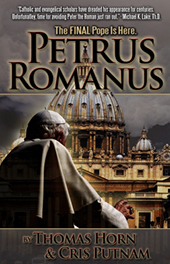A Review of Tom Horn and Chris Putnam’s Petrus Romanus
Printed From: OpenHeaven.com
Forum Name: Older Book Reviews by Steve Eastman
Forum Discription: View Only
URL: http://archive.openheaven.com/forums/forum_posts.asp?TID=39801
Printed Date: 01/17/2017 at 12:31pm
Topic: A Review of Tom Horn and Chris Putnam’s Petrus Romanus
Posted By: Steve Eastman
Subject: A Review of Tom Horn and Chris Putnam’s Petrus Romanus
Date Posted: 05/30/2012 at 7:40pm
|
A Review of Tom Horn and Christ Putnam's "Petrus Romanus" by Steve Eastman, CleanTV Most of us have probably given little thought to who is going to be the last pope. The question isn’t even on the radar. What is in view is all the fuss about the Mayan calendar ending in December 2012. We may not believe it, but we’ve heard about it.
But unlike a well-known religious broadcaster who incorrectly predicted the Rapture multiple times, Horn and Putnam do not claim to be prophets. Their role was to examine evidence from what church scholars have been saying throughout the ages. They ultimately admit that God has the final say on dates, not Christian writers or even more sinister sources. So where did the year 2012 enter the picture? Co-author Chris Putnam credits the writings of a Belgian Jesuit named Rene Thibaut as a major inspiration. “He found the year 2012 as the final year of the Pope in more than one calculation, like five or six different anagrams and encryption codes in the Latin text of the prophecy.” Much of Horn and Putnam’s book references sources outside the evangelical worldview. They defend the approach by reminding readers that not everyone in the Bible who had a prophetic experience had a solid relationship with God. Take Nebuchadnezzar and his dream, for example. Another unique contribution of the writing pair is linking Petrus Romanus to the False Prophet of Revelation. From the time of the Reformation onward, for several centuries, Protestant writers almost unanimously identified the papal office as Anti-Christ. Then the subject somehow became unpopular and is seldom mentioned anymore. Horn and Putnam explain why they believe the False Prophet is a better fit for the final pope. The book successfully surveys Catholic misgivings about the state of the Roman Church — from Traditionalists who are still perplexed about Vatican II to those who believe the full text of the Third Secret of Fatima has never been fully revealed. The authors examine Jesuit Malachi Martin’s assertion that pedophilic Satanism at the heart of the Vatican throughout the College of Cardinals is linked to the “enthronement of the fallen Archangel Lucifer” in the Roman Catholic Citadel on June 29, 1963. Tom Horn and Chris Putnam make a good writing team. Horn is a consummate storyteller and Putnam an equally consummate scholar. Together, they’ve produced a book that can be easily understood by laymen, with a lot of extras for those who appreciate good documentation. © 2012CleanTV http://www.youtube.com/watch?v=iNhayJft5NQ&list=UU0idYat -HCpwk-qOsNwVhew&index=5&feature=plcp - |
 Tom Horn and Chris Putnam hope to turn this around with Petrus Romanus: The Final Pope is Here. Tom Horn calls Petrus Romanus his most important research yet. “When Chris Putnam and I were doing the research, there were two or three times when we stopped in our tracks. Stuff started falling in our laps from dusty corridors inside universities, lost books, all the way to Dane County, Wisconsin and the murder of Edward Kuntz.”
Tom Horn and Chris Putnam hope to turn this around with Petrus Romanus: The Final Pope is Here. Tom Horn calls Petrus Romanus his most important research yet. “When Chris Putnam and I were doing the research, there were two or three times when we stopped in our tracks. Stuff started falling in our laps from dusty corridors inside universities, lost books, all the way to Dane County, Wisconsin and the murder of Edward Kuntz.”